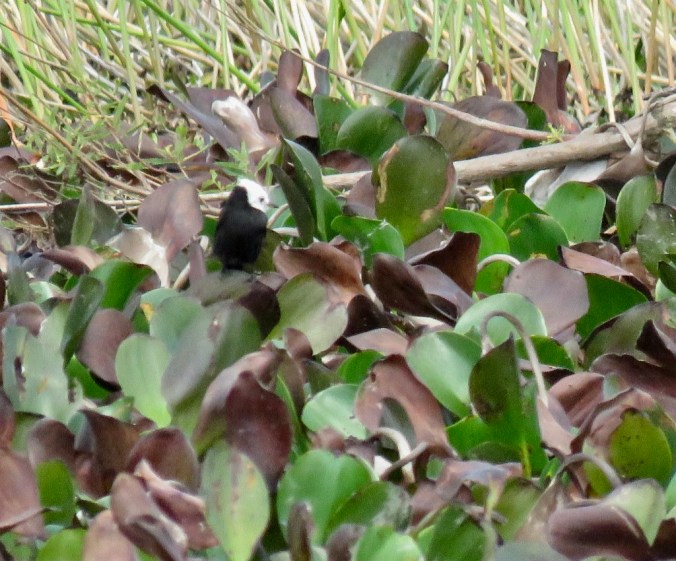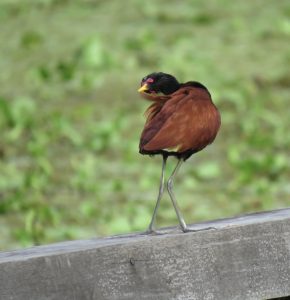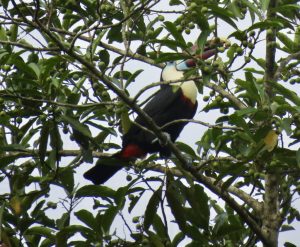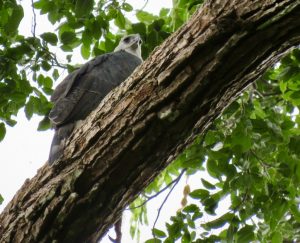22 February 201
Raining again today. David from Ireland (aka Swampy) commented that it has rained every day of our trip and we are in the dry season. I guess the wet season is VERY WET. They use boats to get around instead of cars, we’ve been told by the locals.
We got to sleep-in this morning – for me a whole hour. Instead of waking up at 4:30 a.m. with breakfast at 5:00 a.m., breakfast wasn’t scheduled until 7:30 a.m. We left Atta Lodge today and headed to Iwokrama River Lodge, a short distance away. Of course we are birders so the trip took up to 4 hours, rather than the normal 30 minutes. I did bird the grounds of Atta Lodge this morning and came away with two new birds – Black Nunbird and Pygmy Antwren. The Nunbird bird is mostly black with white on its wings and a red bill. The remaining birds were birds I had already seen before – either in Guyana or elsewhere. Surprisingly, for just the morning, I saw a total of 16 species between periods of rain.




We made a stop along a bridge after our driver spotted a Crimson Topaz (hummingbird). This is a beautiful hummingbird that is red, orange, and purple with a brilliant sparkly greenish yellow throat. I even got a photo.


At another stop, we hiked a small trail and spotted a Bronzy Jacamar sitting on a branch over the trail. All the photographers, including myself, were able to get decent photos of the bird. Jacamars perch quietly on a limb and aren’t flighty like some birds. Of course most daytime birds are busily feeding while the jacamar is simply roosting (resting). Also along this trail was a pair of White-fringed Antwrens. Jack doesn’t like these skulking, hidden birds, but he finally saw the bird well and his face lit up.









We did another hike in search of the Saffron-crested Tyrant Manakin. We found it, although this bird definitely blends in well with its environment. We were also lucky to spot a Red-billed Woodcreeper. As the name implies, Woodcreepers “creep” up trees in search of food. These birds are, for the most part, fairly large in size. They also have good sized bills in which to tunnel into the bark to capture their prey. This particular woodcreeper has a rather large impressive red-colored bill. Most woodcreeper bills are either dark or light colored. But alas I didn’t get a photo of the bird as it was always moving from one tree to another.

We made it to Iwokrama River Lodge around 2:00 p.m., and quickly checked into our rooms before having lunch. We resumed birding with a boat ride at 5:00 p.m along the Essequibo River. However, after lunch and before the boat trip was down time where we could rest, catch up on what’s happening outside of our little cabin, take a shower, read, bird, or any combination of the above. I started out birding, but it quickly became too hot to keep that up. I did see a few different birds, but I felt like the sun was melting my skin off. Yeah, that hot.












23 February 2019
We birded the lodge grounds this morning, including a portion of Bushmaster Trail. I was surprised at how many birds there were in the area. Along the trail we had a number of birds that specialize in eating ants. Yay!!! We love ant eating birds. At one place we heard a cacophony of birds calls and watched several different Antbirds in a feeding frenzy. The trail in front of us was swarming with ants for at least 50 feet or so. As they advanced down the trail, we retreated. And then the next thing you know, the ants are gone. I guess they left the trail while I wasn’t watching. Glad it happened though. A few army ants are bad enough but thousands of them are not something you want to be in the middle of.
And where there is an ant swarm there is the possibility of seeing the difficult to see Rufous-winged Ground Cuckoo – which loves ants apparently. However, despite the ant swarm, the Ground-Cuckoo was a no show.







After lunch we had about two hours to just relax and enjoy the beautiful day. It is very pleasant here at the lodge and we are the only guests. Around 3:30 p.m. we gathered for another round of rainforest birding. This time we walked the road from the lodge to the main highway – about 1.6 km. A nice walk – no jungle trail, and good birding. We got to see the Ferruginous-backed Antbird. This is a beautiful bird that likes to slowly walk on the forest floor in search of food – ants. Unfortunately, such activity is not conducive to getting a good photograph of the bird. At least not by me.
















Further along the road we had a Spotted Puffbird. Now that bird I could photograph. I love the Puffbirds. They usually sit quietly on a limb high off the ground, but rarely hidden by vegetation. They do require you to crank you head back when you look up to see them, but well worth the sore neck. The third cool bird was a Rose-breasted Chat. This chat species is in a different family than our North American Yellow-breasted Chat. As its name implied, the bird has a rosy chest so a little easier to spot than birds that blend in really well with their environment.
We stayed out past sundown in order to find and see the Northern Tawny-bellied Screech Owl. Who doesn’t like owls? With some coaxing, this little owl came in close for us to get great views and decent photographs. We returned to the lodge for dinner, to go over our checklist of birds observed and/or heard, and then off to our cottages to get ready for the following day.





The spider was quite large.
24 February 2019
Despite today being a travel day I saw a total of 82 different species. Not too shabby? Of those, 21 were birds I hadn’t yet seen on this trip. I don’t have a running list of all birds seen (aka “life list”) so I don’t know how many of these are life birds. But you know what? It really doesn’t matter because I never tire of seeing birds – new or old. My favorite bird?– the one I’m looking at.
For this trip we’ve had three SUVs for transportation. We take turns riding in the three different vehicles. Today, Veronica, Jack, and I were in the first vehicle and we got to see a Tapir walking along side the road. This strange animal looks half-pig and half small horse. Bizarre. Here is a link to check out the Tapir: https://en.wikipedia.org/wiki/Tapir.






















After lunch, we made a quick transition from the tropical rainforest at Iwokrama River Lodge to the savannah grasslands at Caimen House. While I do love the tropical rainforest, I am totally in love with Guyana’s savannah region. Surprisingly we saw more birds in this region where we spent the afternoon compared to the rainforest where we spent the morning. Of course, I will admit it is much easier to see birds in the open savannah than the enclosed rainforest – less places for the birds to hide.

























Before arriving at the Caimen House around 7:00 p.m, we made a stop at a great little wetland area to search for the Ferruginous Pygmy-Owl and have our nightly sundowner drink. Well I don’t drink alcohol, but everyone else had their shot of Guianan El Dorado Rum. And we got the pygmy owl. They have the word “pygmy” in their name for a reason. This is one small owl. Luckily there was enough light left to get a photo or two. I told Jack that I think I am becoming obsessed with getting photographs of these birds, instead of just taking the time to really view them through my binoculars – not something I want to have happen.












25 February 2019
We had two goals this morning: Find the Giant Anteater and Crested Doradito. We got both. Yay!!! In fact, we managed to see two different anteaters today. Unfortunately, the first one was found and rounded up for us by a local villager hired to use a motorcycle. I guess they wanted to ensure our goal. I hate to see the animal harassed this way. The locals feel the anteaters are old women who have died and become witches. So they traditionally have hunted and killed the anteaters. Where people come up with such ridiculous beliefs is beyond me or beyond reason. The tourists’ desire to see Giant Anteater may be its saving grace? If the tourists want to come to the area to see these large animals, maybe the locals won’t kill them. That is one benefit.











The Crested Doradito is restricted to a very small, specific area so we were happy to find it at a new location. Hopefully this means it is expanding its range. This is good news for this rare bird. Both Jack and I got really good looks at this secretive bird. The bird likes to pop up on a reed blade, look around briefly, then drop back down. After this sighting we headed further into the savannah to another area where the bird had been sighted. Here we saw our second Giant Anteater. It was upwind of us and slowly ambled its way to within 20-30 feet of us, before smelling us, and quickly giving us the evil eye and taking off (I’m sure we don’t smell that great after being out in the hot sun and perspiring). I did take a video of the animal. I love its markings and form.









We got back to the lodge around 11:00 a.m. (it’s hot in the savannah this time of year), and had some down time before lunch. I like these down times as it gives me time to write my blog and download photos. There isn’t much time after dinner and completing our daily checklist, which generally ends around 9:00 p.m., to work on my blog. With a wake-up time of 5:00 or 5:30 a.m., who has the energy to do anything but to fall into bed and sleep.





Later, around 3:00 p.m., we loaded onto a boat and made our way downstream on the Runpununi River, searching for shorebirds, waterbirds (herons, egrets), and whatever other birds had set up residence along the river. We got to see the Pied Lapwing, which is one of the birds I was really hoping to see. We got a quick view of the Crestless Currasow, a large black bird without a crest like most currasows.





























The intent was to return to our lodge around 7:00 p.m. but we took a detour to an oxbow lake and spent too much time there. We didn’t return to the lodge until almost 8:00 p.m. Not always fun being on the river when its dark – hidden hazards. We did have a good boat captain, however. Also, we did see some Boat-billed Herons we typically wouldn’t see during the day, but when we finally got back to the lodge I was one hungry birder.

There was some concern among some of the people on the tour that one of the tour participants was using his flashlight inappropriately. Our local guide was busy looking for owls, nighthawks, and nightjars after dark, but this participant was also sweeping the river. In doing so, he flushed a large number of swallows off their night-time roost. According to one participant, the swallows will now have a hard time getting back to their perch safely and will spend hours circling the area, eventually dropping into the river from exhaustion and drowning. While birders are bird ambassadors, they don’t always have the birds best interest at heart. For some the most important thing is to “tick” the bird off their life list. Us birders need to consider what our activities do to the birds. It’s not always good.
26 February 2019
We had a long drive ahead of us in order to get to a particular area to see the Sun Parakeets. This meant a 3:30 a.m. walk up call and a 4:00 a.m. departure. Boy was I tired. The reward for the early morning departure was we did see the Sun Parakeets. These birds are magnificent – a very bright yellow and hard to miss when seen in the tree tops. We had a local person help guide us to the area and he regularly sees the birds so took us right to them. The valley we traveled in is worthy of national park status because of its scenic beauty. Fortunately, it is part of a local community reserve and protected. Sun parakeets in the wild are endangered. Unfortunately, they are favorite birds of avian collectors (those people who like to have caged birds).


















After checking out the parakeets and other birds in the area, we headed into the village of Karasabai for lunch. Lunches here are pretty basic: chicken, beef, or fish (often all three), rice, beans, cassava (not something I care to eat), and occasionally a salad. While they generally say don’t eat salads in South America, we haven’t had a problem. We’ve also drank the tap water (often filtered or UV treated), and the fresh juice drinks – Yum!!!





After lunch, we proceeded to drive another three hours to our next destination – Manari Ranch. We did stop for birds along the way, including seedeaters and raptors.






Accommodations at the ranch are pretty basic and showing their age. We got settled into our rooms and then I went out and birded the grounds. Oh, and there is a tame river otter at the Manari Ranch that is essentially a pet. It lives in the river but is very sociable and when it hears people arriving it comes running in from the river to greet people. The river otter likes to “get to know you”. One woman in our group was really put out by the attention this otter gave her. He seemed to especially like her, which didn’t please her one little bit. The otter has the habit of wanting to follow you around, sniff you, and hug your leg. And, very curious. We were told to hold tight to our cameras and binoculars as it likes to climbs up on chairs and tables.














We had an early dinner because tomorrow we are getting up even earlier than today – 2:30 a.m. with a 3:00 a.m. departure. Ugh. Even for me that is too early. Jack is exhausted by it and it seems to have exacerbated his head cold congestion and night cough.
27 February 2019
For some reason I couldn’t sleep last night. I think I only got “maybe” 1.5 hours of sleep. With an early start I am one tired birder.
Our goal this morning is to find the Red Siskin. This is a very localized species, and we traveled three hours one way to see this bird. And luckily we got great looks at several of the birds. Hooray!!!




Next we searched, and found, the Sharp-tailed Ibis. This bird reminds me somewhat of the bald-faced ibis found in Africa. Unbeknownst to me, with my camera I captured the bird catching and eating a frog. And it was a big frog.







We had a great lunch at the Wichabai Ranch house – a wonderful place. Best lunch yet. The place is managed by a couple who are not Guianan, so they put a western twist to their meals. The ‘ranch’ overlooks a beautiful wetland/small open water area, rich in birds. How many people can say they have Jabiru storks in their yard! The owners are building some cabins so maybe this will become a future overnight (or longer) tour stop.













After lunch we went in search of the Crested Tachuri, another Guianan Shield Endemic. This is a very small bird, but we got decent looks. The bird moves around a lot so I didn’t even bother to try and take a photo. Not sure I could have found it among the grasses.
Roads in this area (a generous term) are dirt tracts with many arteries so we always marveled how the driver knew where to go. Since it took us three hours to get to the Red Siskin location (Wichabai Ranch), we headed back to our lodging at Manari Ranch shortly after finding the Crested Tachuri.
At the lodge was an ex-pat couple living in Panama. We’ve seen them several times throughout our tour. They coordinated the trip on their own and are birding with local guides. I’m not sure how they are arranging in-country transportation. Many of the lodges are difficult to get to and the road system is bewildering. Considering some of the personalities on our tour a ‘private tour’ might not be a bad way to go birding. We have a couple of people who are scope hogs. They think the trip is only for them. These are definitely people who should go on private trips – alone.
28-Feb-19
I slept like a log, only getting up once. We didn’t have to get up today until 4:30 a.m. (as if that is a decent hour according to Jack). I don’t think Jack signed on for these early risers, at least not as many as we’ve had. But we have to travel some distance to get to the birds and there aren’t a lot of lodging options. As I mentioned, lodging outside of Georgetown is pretty basic. We haven’t had a hot shower since we left Georgetown. And despite the temperatures outside, I prefer hot showers to cool or cold showers. Many of the eco-lodges utilize solar power for lights but evidently not for solar showers.
The key birds today were the Rio Blanco Antbird and the Hoary-throated Spinetail. It took us awhile to get on the antbird. The bird was close as we heard it responding to the playback call, but it took awhile for it to appear. Not everyone got good looks so after going and finding the spinetail (cool bird), many went back to try for the Antbird again. Since I had seen it well before, as had Veronica, we went to the river (which borders Brazil) to search for new birds.









After getting our target birds for the morning, we went to a nearby wetland and checked for the Pinneated Bittern and Masked Duck. The Masked Duck we found (a small duck, so you really had to look hard to see them), but no luck in seeing the bittern. The duck – mainly females – were loafing among the lily pads. Some of the lily pads leaves are red and looked like the male duck. We saw quite a few species here. I love wetlands. Wish we had more of them – a tragedy that so many are lost or fragmented everywhere to the crush of development.






As we were headed back we stopped at a few small wetlands to check one last time for the Pinneated Bittern. And, success! We found one with its classic bittern poise and then a great view as it walked about and then flew off. This is a large bittern. There was a little testiness going on within our group with regards to seeing the bird in the scope – remember when I mentioned the scope hogs. What is frustrating, is that we’ve had three scopes the entire trip. However, today when we needed all three scopes the most, the two people who brought scopes left them back at the lodge. And these two people are the scopes hogs.
For such a short birding day – only four hours – I saw a total of 44 species, of which 11 were new for the trip. And with the last bird being the Pinneated Bittern, not a bad way to complete a birding tour. We returned to our lodging for lunch and final packing.
We had to depart our lodging around 2:15 p.m. to catch a 4:30 p.m. flight from Lethem, Guyana (border of Brazil) to Georgetown. The flight only took about 55 minutes. We arrived in Georgetown and were escorted to our hotel – The Grand Coastal Hotel. I had asked Ron Allicock, our guide, to make sure we were given a room in the quiet portion of the hotel. He failed me again. I wasn’t too impressed by our guide. I felt that he wasn’t giving us 100% of his time and effort. I’m not sure I would not recommend him to any of my birding friends. Of course in Guyana you don’t have many choices for guides.

We had dinner at an Indian Restaurant. On the menu they have Alaskan Lobster. Okay….. As any Alaskan knows, there are no lobsters in Alaska. We have crab aplenty (or at least we used to), but no lobster. Jack and I had a good laugh. The food was good, but it was no India Oven, our favorite Indian restaurant anywhere (psst … its located in Portland Oregon on Belmont Street).
1 March 2019
To catch our flight from Guyana to Florida, we got up around 1:50 a.m. Yes, a.m. – that wasn’t a typo. Our plane from Guyana left for Miami at 5:35 a.m., but we needed to get to the airport two hours ahead of time and it takes an hour to get to the airport from our hotel. We flew Caribbean Airlines. We made a stop in Port of Spain, Trinidad. Most of the people got off the plane there, but the plane quickly filled up with people flying to Miami. On the second leg, I had a woman sit behind me and I think she was the rudest flier I’ve experienced sitting behind me – constant movement, jerking the back of my seat, noisy, and totally oblivious. And all I wanted to do was sleep. I think I slept a total of 30 minutes on the 4.5-hour flight. Needless to say I am one tired birder. Too many early mornings the past few days. I think I would recommend to Ken Wilson of Talon Tours that he switch the schedule around so that you fly from Georgetown to Lethem, then bird your way to Surama, then take a flight to falls and then onto Georgetown, finishing with birding in the Georgetown area. That way you don’t end the bird tour with the really early mornings (like we did), but start out that way. Recovery time with afternoons off is nice but one’s body never really recovers from the exhaustion of early-morning departures.
I would definitely return to Guyana. It is a beautiful country and is lightly developed with a relatively intact rainforest (80% of the country) – they practice sustainable logging. Gold and bauxite mining are a different story. With the potential of off-shore oil and gas development who knows what the future holds. I hope Guyana stays “Green.” I especially liked the savannah area – very scenic and reminds one of the classic view of Africa (without ungulates). Guyana does apparently have a healthy jaguar population. Unfortunately, we didn’t see one. I also found birding the savanna to be much easier. No dense vegetation to forage through in search of Antwrens, Antbirds, Antshrikes, and Antpittas. Jack calls the rainforest birds “one-second” birds because your view is often very limited.
Tomorrow we catch a flight from Fort Lauderdale to Phoenix Arizona. We will stay with friends in the Phoenix area and then continue with our camper van travels.
Until then …
IT’S ALWAYS A GREAT DAY TO BIRD


















































































































































































































































































Recent Comments